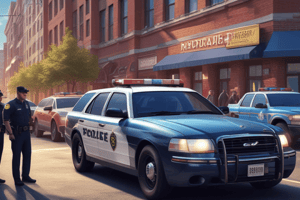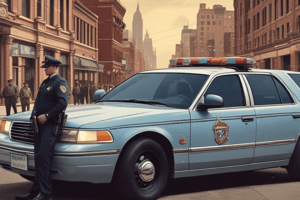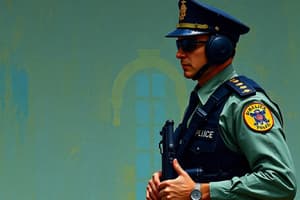Podcast
Questions and Answers
What is the primary focus of routine patrol as the most common method of police patrol?
What is the primary focus of routine patrol as the most common method of police patrol?
- Conducting in-depth criminal investigations.
- Focusing on community engagement events only.
- Proactive crime prevention and maintaining a visible presence. (correct)
- Responding to 911 calls exclusively.
Within a larger police command area, what is a smaller, designated patrol area typically referred to?
Within a larger police command area, what is a smaller, designated patrol area typically referred to?
- Beat (correct)
- Precinct
- Jurisdiction
- Sector
Which of the following best describes 'discovery crimes'?
Which of the following best describes 'discovery crimes'?
- Crimes witnessed by victims or witnesses as they occur.
- Crimes that are detected after they have already occurred, often with a time delay. (correct)
- Crimes solved through forensic evidence only.
- Crimes that are instantly reported via 911.
What was the primary purpose of creating the 911 system in 1968?
What was the primary purpose of creating the 911 system in 1968?
Which type of crime is most likely to be handled with differential police response strategies?
Which type of crime is most likely to be handled with differential police response strategies?
What is a crime called when a victim or witness observes the crime as it unfolds?
What is a crime called when a victim or witness observes the crime as it unfolds?
Which of the following is the primary conclusion of the Kansas City Preventive Patrol experiment?
Which of the following is the primary conclusion of the Kansas City Preventive Patrol experiment?
According to research in Minneapolis, which season typically sees the highest volume of calls for police service?
According to research in Minneapolis, which season typically sees the highest volume of calls for police service?
Which of the following is a potential criticism of hot spot policing?
Which of the following is a potential criticism of hot spot policing?
A police officer stops a vehicle based on a broken tail light and further investigates potential drug activity based on the driver's nervous behavior. What type of police stop is this initially classified as?
A police officer stops a vehicle based on a broken tail light and further investigates potential drug activity based on the driver's nervous behavior. What type of police stop is this initially classified as?
What level of proof is required for a police officer to conduct a Terry Stop?
What level of proof is required for a police officer to conduct a Terry Stop?
Which of the following describes the process of gathering crime-related information to achieve specific law enforcement goals?
Which of the following describes the process of gathering crime-related information to achieve specific law enforcement goals?
What academic field broadly examines legal questions and their implications?
What academic field broadly examines legal questions and their implications?
What term describes serious crimes that are no longer actively investigated due to the prioritization of more recent offenses?
What term describes serious crimes that are no longer actively investigated due to the prioritization of more recent offenses?
An individual or business that knowingly buys and sells stolen property is commonly known as what?
An individual or business that knowingly buys and sells stolen property is commonly known as what?
What legal concept occurs when law enforcement induces a person to commit a crime they would not have otherwise committed?
What legal concept occurs when law enforcement induces a person to commit a crime they would not have otherwise committed?
Which of the following individuals share the exact same DNA?
Which of the following individuals share the exact same DNA?
In the context of evidence, what type of evidence requires an inference to connect it to a conclusion of fact?
In the context of evidence, what type of evidence requires an inference to connect it to a conclusion of fact?
What legal condition is indicated when a person is physically restrained by the police and is not free to leave?
What legal condition is indicated when a person is physically restrained by the police and is not free to leave?
What term describes a situation where a person makes decisions independently based on their own reasoning and judgment?
What term describes a situation where a person makes decisions independently based on their own reasoning and judgment?
Flashcards
Routine Preventive Patrol
Routine Preventive Patrol
Patrol in a specific geographic area, aiming for visibility and quick response.
Beat
Beat
A localized patrol zone within a larger policing district.
Discovery Crimes
Discovery Crimes
Crimes discovered after they have occurred, without witnesses.
911
911
Signup and view all the flashcards
In-Progress Crime
In-Progress Crime
Signup and view all the flashcards
Kansas City Preventive Patrol
Kansas City Preventive Patrol
Signup and view all the flashcards
Police Interrogation
Police Interrogation
Signup and view all the flashcards
Criminal Intelligence
Criminal Intelligence
Signup and view all the flashcards
Jurisprudence.
Jurisprudence.
Signup and view all the flashcards
Entrapment
Entrapment
Signup and view all the flashcards
Circumstantial Evidence
Circumstantial Evidence
Signup and view all the flashcards
Inculpatory Evidence
Inculpatory Evidence
Signup and view all the flashcards
Exculpatory Evidence
Exculpatory Evidence
Signup and view all the flashcards
Custody
Custody
Signup and view all the flashcards
Stop and Frisk
Stop and Frisk
Signup and view all the flashcards
Traffic Stops in Hot Spot Policing
Traffic Stops in Hot Spot Policing
Signup and view all the flashcards
Announcing a crackdown
Announcing a crackdown
Signup and view all the flashcards
Solving a Homicide
Solving a Homicide
Signup and view all the flashcards
U.S Supreme Court case Miranda V. Arizona
U.S Supreme Court case Miranda V. Arizona
Signup and view all the flashcards
Terry v. Ohio
Terry v. Ohio
Signup and view all the flashcards
Study Notes
-
The most common method of police patrol is not specified.
-
A smaller patrol area within a larger command area is frequently called a "beat".
-
Discovery crimes are crimes discovered after they have occurred.
-
911 serves as the national emergency phone number and was created in 1968.
-
Examples of crimes most likely eligible for a differential police response are minor offenses like property damage without suspects.
-
A crime where a victim or witness sees the crime occurring is called a "crime in progress".
-
The Kansas City Preventive Patrol experiment found that increased preventive patrol had no impact on the amount of crime committed.
-
According to research conducted in Minneapolis, the Summer season had the most calls for service.
-
Criticisms of Hot Spot Policing include concerns about displacement, community relations, and civil rights.
-
Types of Police Stops include consensual encounters, Terry stops, and arrests.
-
The level of proof needed to conduct a Terry Stop is "reasonable suspicion".
-
Intelligence-led policing is the process of collecting crime-related information to reach certain goals.
-
Jurisprudence broadly refers to the academic field that addresses legal questions.
-
Cold cases are usually serious crimes that are no longer being actively investigated because more recent crimes are necessarily the priority.
-
A(n) fence is a person or business that buys and sells property that is known to be stolen.
-
Entrapment occurs when the police induce someone to commit a crime the person would not have otherwise committed.
-
People who share the exact same DNA are identical twins.
-
Circumstantial evidence is indirect and requires inference, inculpatory evidence suggests guilt, exculpatory evidence suggests innocence, direct evidence proves a fact directly, indirect evidence is similar to circumstantial, DNA (biological) evidence comes from biological material, a confession is an admission of guilt, and physical evidence is tangible items.
-
When a person is under physical control of the police and is not free to leave, it is called "custody".
-
When a person makes decisions based on their own judgment, it is called "discretion". An example of this is a police officer deciding whether to issue a warning or a ticket for a traffic violation.
-
Miranda v. Arizona established the requirement that suspects be informed of their constitutional rights prior to interrogation. Terry v. Ohio established that police may stop and frisk a person if they have reasonable suspicion that the person has committed, is committing, or is about to commit a crime and has a reasonable belief that the person may be armed and dangerous. Tennessee v. Garner addressed the use of deadly force against a fleeing suspect. Arizona v. Gant concerned the scope of a search incident to arrest. Loving v. Virginia invalidated laws prohibiting interracial marriage. Katz v. United States concerned the nature of the right to privacy and the legal definition of a "search".
-
The type of activities most common of the police in the following environments are not listed.
-
An important event that can provide an interpretation of departmental policy and serve as the basis on which police officers may model desired actions while performing the tasks of the job is "roll call training".
-
If a police officer fails to abide by the unwritten rules that govern the culture of policing, they will most likely face ostracism and difficulty in their work.
-
The reviewing of complaints against the police involves Internal Affairs, citizen review boards, and other oversight bodies.
-
When there is ambiguity in the law and policy, an officer might use their ethical framework as guidance on making difficult decisions.
-
A person can be taught ethics, effective ethics training requires scenario-based learning, discussion, and critical thinking.
-
Probable cause is a reasonable belief that a crime has been committed, reasonable suspicion is a belief based on articulable facts that a crime may be occurring. Beyond a reasonable doubt is the standard required for criminal convictions. Preponderance of the evidence means more likely than not and is the standard for civil cases.
-
When a person is placed in handcuffs, it generally means the person is under arrest.
-
The First Amendment concerns freedom of speech, religion, press, assembly, and petition. The Fourth Amendment concerns protection against unreasonable searches and seizures. The Fifth Amendment concerns protection against self-incrimination and double jeopardy. The Sixth Amendment concerns the right to counsel and a speedy trial. The Eighth Amendment concerns protection against cruel and unusual punishment.
-
A search warrant is a court order allowing law enforcement to search a specific location. An arrest warrant is a court order allowing law enforcement to arrest a specific person. An injunction is a court order requiring a person to do or cease doing a specific action. A citation is a written order to appear in court.
-
If an arrest occurs outside of a house, officers may search the home of the arrestee under exigent circumstances or with a warrant.
-
Possible positive results of “no-knock” warrants: prevent destruction of evidence and reduce risk to officers. Negative results: increased risk of violence and property damage, and violations of civil liberties.
-
Exceptions to the exclusionary rule include the inevitable discovery doctrine, the good faith exception, and the independent source doctrine.
-
Anxiety is a state of worry, stress is a response to demands, burnout is emotional and physical exhaustion, and post-traumatic stress disorder (PTSD) is a mental health condition triggered by a traumatic event. Causes vary for each, and diagnosis involves clinical assessment, self-reporting, and sometimes physiological tests.
-
A perceived workplace stressor that may have an especially negative impact on the recruitment of female officers is sexual harassment.
-
Circadian rhythm is the body's natural sleep-wake cycle.
-
When a police officer is assaulted, the most likely weapon used by the assailant is not specified.
-
Police vehicle pursuits are when officers chase a suspect in a vehicle. The trend in their use is generally decreasing due to safety concerns.
-
Police officers should stop a foot pursuit when the risk to themselves or the public outweighs the need to apprehend the suspect.
-
On average research suggests that very few hours are devoted to stress management at the police academy.
-
Terry Stops are frequently conducted.
-
Citizens do not always perceive the police as acting properly when they are stopped for a traffic offense and their vehicles are searched, and may not always find the police acting respectfully in most of these searches.
-
Traffic stops are a common tactic in hot spot policing.
-
When police begin a crackdown, they sometimes announce their intent to increase their presence and enforcement activity to the public.
-
Intensive resource allocation in a police department is when a department focuses a lot of their resources into one task.
-
The major findings in the Kansas City Preventive Patrol Experiment were that increased or decreased patrol did not significantly affect crime rates, citizen satisfaction, or attitudes toward the police.
-
Criminal investigations within police departments are typically conducted by detectives or investigators.
-
For a crime to be considered solved, it is not always necessary for a criminal conviction to occur; it can be cleared by arrest or exceptional means.
-
A DUI checkpoint is a roadblock where police stop drivers to check for alcohol impairment.
-
In most solved homicides, the person responsible is taken into custody relatively quickly.
-
Issues/circumstances that influence the police in whether to pursue or not to pursue a criminal investigation include the severity of the crime, solvability factors, and resources available.
-
All else equal, people of color are more likely to be arrested than white people.
-
Impacts on a police officer’s discretion on the job include department policies, community expectations, and individual officer biases.
-
In the Valentine’s Day Massacre, seven members of the North Side Gang were murdered, allegedly by Al Capone’s South Side Italian gang. The results are not specified.
-
An example of exigent circumstances is when officers enter a building without a warrant because they heard screams, indicting someone is in danger.
-
A hotel clerk may not give valid consent to search a hotel room to the police.
-
During a stop and frisk, officers are permitted to perform a pat down in order to determine if the person has a weapon.
-
There are exceptions to the Miranda requirements like the public safety exception.
-
Stress is not always a negative event in our lives; it can be a motivator.
-
Major stressors for police officers include exposure to trauma, organizational issues, and public scrutiny.
-
The most common perpetrators of sexual harassment in law enforcement agencies are male officers.
-
Research suggests that post-traumatic stress disorder is often found to be more common among police officers than among members of other occupations not typically exposed to traumatic situations.
-
Most “on the job” deaths in policing are not always the result of homicides, they can be caused by accidents or health problems.
-
In the JonBenet Ramsey Case, JonBenet Ramsey was found murdered in her home. The suspects were her parents, John and Patsy Ramsey. Evidence included a ransom note and inconsistencies in the family's statements. The case remains unsolved.
-
In the Ernesto Miranda case, Ernesto Miranda was arrested and interrogated without being informed of his rights. The case was reviewed by the US Supreme Court because it raised questions about the admissibility of confessions obtained without informing suspects of their rights. The Court ruled that suspects must be informed of their rights prior to interrogation. The ruling resulted in the creation of the Miranda warning.
Studying That Suits You
Use AI to generate personalized quizzes and flashcards to suit your learning preferences.




